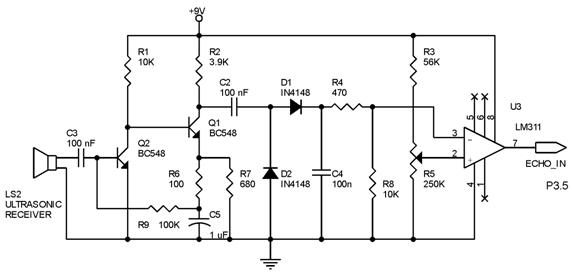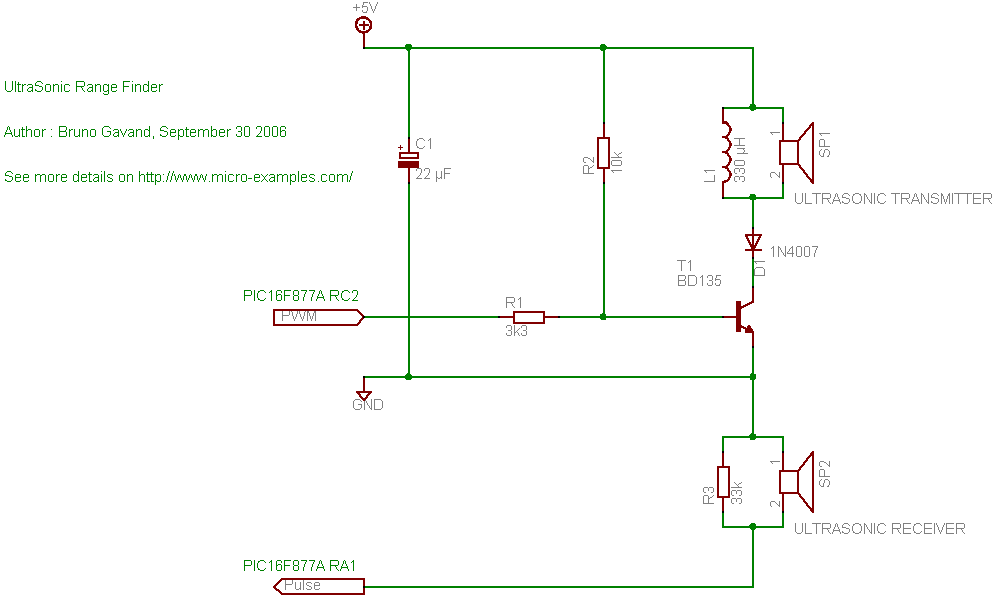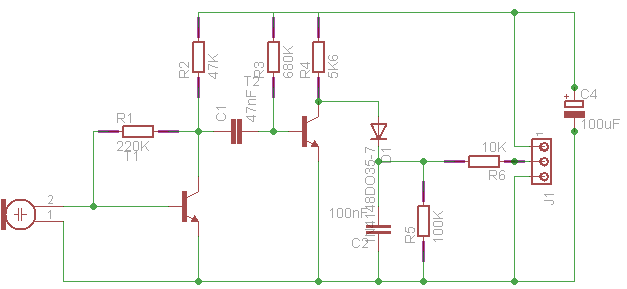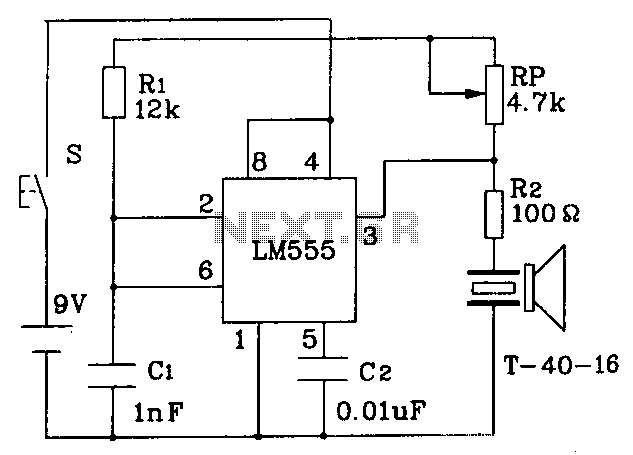
ultrasonic distance measurer

Techniques for an echo sounder used to measure ocean depth can be implemented with an ultrasonic distance measuring device. This device uses a circuit similar to the one described in the previous article, which includes a series of ultrasonic transmitter and receiver components. The operating principle of the echo sounder is illustrated in Figure 1. An ultrasonic pulse, generated at a frequency of approximately 41 kHz for 12 cycles, is transmitted from the ultrasonic transmitter. When this pulse encounters an object, it is reflected back and captured by the ultrasonic receiver. By measuring the time interval between the transmission of the pulse and the reception of its reflection, the distance to the object can be calculated. In this project, an LED light serves as the visual indicator; however, a 220V lamp can also be utilized. Figure 2 presents a revised version of the digital clock circuit from the previous article, adapted for this application. The decimal point on the display unit is activated by resistor R8. Each time the Start button is pressed, the AT89C2051 microcontroller generates ultrasonic pulses at pin P3.4, which are emitted by the circuit shown in Figure 3. The output from pin P3.5 connects to the ultrasonic receiver circuit depicted in Figure 4, allowing the AT89C2051 to monitor the time interval for the arrival of the pulse reflection. The measurement results are displayed on a seven-segment viewer, indicating the distance in centimeters, with one decimal point.
The ultrasonic distance measuring device operates on the principle of time-of-flight measurement. The ultrasonic transmitter emits a pulse of sound waves that travel through the air until they reach an object. Upon hitting the object, the sound waves are reflected back towards the receiver. The time taken for the pulse to travel to the object and back is critical in determining the distance, calculated using the formula: Distance = (Speed of Sound × Time) / 2. The speed of sound in air is approximately 343 meters per second at room temperature, which can be used to convert the measured time into a distance reading.
The AT89C2051 microcontroller plays a vital role in controlling the timing of the ultrasonic pulses and processing the received signals. It initiates the pulse transmission when the Start button is pressed and begins counting the time interval until the echo is received. The use of a seven-segment display allows for a clear visual representation of the distance measurement, making it user-friendly. The circuit design ensures that the system is efficient and responsive, providing real-time distance measurements suitable for various applications, including underwater exploration and depth measurement.
The integration of the LED or a 220V lamp serves as an indicator for the user, providing a visual cue that enhances the usability of the device. The circuit's adaptability, as demonstrated by the modifications made to the digital clock circuit, exemplifies its versatility in different measurement scenarios. Overall, this ultrasonic distance measuring device is a practical tool for accurately gauging distances and depths in various environments.Borrowing techniques echo sounder used to measure ocean depth, distance measuring device can be made with an ultra sonic. Gauge this distance using the same circuit with Digital Clock in the last article, coupled with a series of transmitter and receiver Ultra Sonic.
The working principle echo sounder to measure the distance depicted in Figure 1. Ultrasonic pulse, which is an ultrasonic signal with a frequency of approximately 41 KHz for 12 periods, transmitted from the ultrasonic transmitter. When the pulse of the objects barrier, this pulse is reflected, and received by the ultrasonic receiver.
By measuring the time interval between when the pulse transmitted and received pulse reflections, the distance between the measuring device and the object can dihitung. lasi barrier, in this project the light used is a LED light. if you want to use the lamp at 220V. Figure 2 is a Digital Clock circuit in the last article which was revised for this purpose. Decimal point on the display unit is turned on with the prisoners R8. Each time the Start button is pressed, AT89C2051 generate ultrasonic pulses at Pin P3. 4 emitted by the circuit of Figure 3, then through pin P3. 5 is connected to the ultrasonic receiver circuit in Figure 4, while measuring the time interval to monitor the arrival of pulse reflection AT89C2051.
Results of measurement time, with a little mathematical calculation is shown in the viewer seven segment as the distance scale, with units of centimeters and 1 point behind the point desimal. mengukur sea depth, distance measuring device can be made with ultra-sonic. Gauge this distance using the same circuit 🔗 External reference
The ultrasonic distance measuring device operates on the principle of time-of-flight measurement. The ultrasonic transmitter emits a pulse of sound waves that travel through the air until they reach an object. Upon hitting the object, the sound waves are reflected back towards the receiver. The time taken for the pulse to travel to the object and back is critical in determining the distance, calculated using the formula: Distance = (Speed of Sound × Time) / 2. The speed of sound in air is approximately 343 meters per second at room temperature, which can be used to convert the measured time into a distance reading.
The AT89C2051 microcontroller plays a vital role in controlling the timing of the ultrasonic pulses and processing the received signals. It initiates the pulse transmission when the Start button is pressed and begins counting the time interval until the echo is received. The use of a seven-segment display allows for a clear visual representation of the distance measurement, making it user-friendly. The circuit design ensures that the system is efficient and responsive, providing real-time distance measurements suitable for various applications, including underwater exploration and depth measurement.
The integration of the LED or a 220V lamp serves as an indicator for the user, providing a visual cue that enhances the usability of the device. The circuit's adaptability, as demonstrated by the modifications made to the digital clock circuit, exemplifies its versatility in different measurement scenarios. Overall, this ultrasonic distance measuring device is a practical tool for accurately gauging distances and depths in various environments.Borrowing techniques echo sounder used to measure ocean depth, distance measuring device can be made with an ultra sonic. Gauge this distance using the same circuit with Digital Clock in the last article, coupled with a series of transmitter and receiver Ultra Sonic.
The working principle echo sounder to measure the distance depicted in Figure 1. Ultrasonic pulse, which is an ultrasonic signal with a frequency of approximately 41 KHz for 12 periods, transmitted from the ultrasonic transmitter. When the pulse of the objects barrier, this pulse is reflected, and received by the ultrasonic receiver.
By measuring the time interval between when the pulse transmitted and received pulse reflections, the distance between the measuring device and the object can dihitung. lasi barrier, in this project the light used is a LED light. if you want to use the lamp at 220V. Figure 2 is a Digital Clock circuit in the last article which was revised for this purpose. Decimal point on the display unit is turned on with the prisoners R8. Each time the Start button is pressed, AT89C2051 generate ultrasonic pulses at Pin P3. 4 emitted by the circuit of Figure 3, then through pin P3. 5 is connected to the ultrasonic receiver circuit in Figure 4, while measuring the time interval to monitor the arrival of pulse reflection AT89C2051.
Results of measurement time, with a little mathematical calculation is shown in the viewer seven segment as the distance scale, with units of centimeters and 1 point behind the point desimal. mengukur sea depth, distance measuring device can be made with ultra-sonic. Gauge this distance using the same circuit 🔗 External reference





